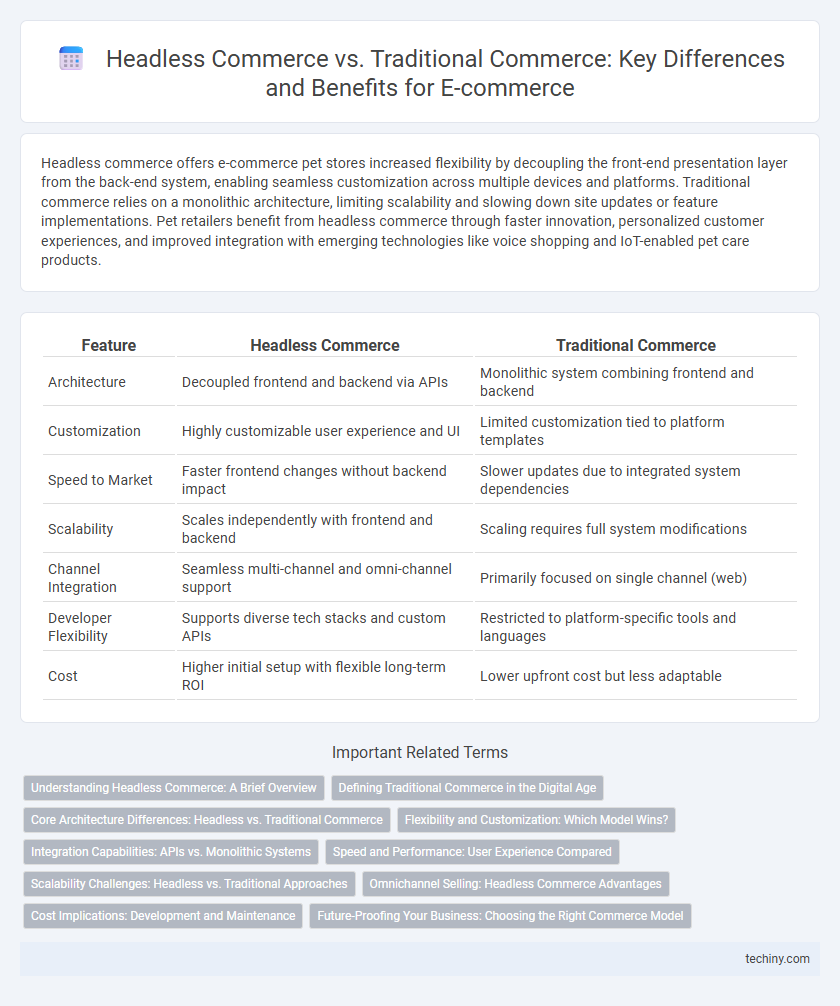Headless commerce offers e-commerce pet stores increased flexibility by decoupling the front-end presentation layer from the back-end system, enabling seamless customization across multiple devices and platforms. Traditional commerce relies on a monolithic architecture, limiting scalability and slowing down site updates or feature implementations. Pet retailers benefit from headless commerce through faster innovation, personalized customer experiences, and improved integration with emerging technologies like voice shopping and IoT-enabled pet care products.
Table of Comparison
| Feature | Headless Commerce | Traditional Commerce |
|---|---|---|
| Architecture | Decoupled frontend and backend via APIs | Monolithic system combining frontend and backend |
| Customization | Highly customizable user experience and UI | Limited customization tied to platform templates |
| Speed to Market | Faster frontend changes without backend impact | Slower updates due to integrated system dependencies |
| Scalability | Scales independently with frontend and backend | Scaling requires full system modifications |
| Channel Integration | Seamless multi-channel and omni-channel support | Primarily focused on single channel (web) |
| Developer Flexibility | Supports diverse tech stacks and custom APIs | Restricted to platform-specific tools and languages |
| Cost | Higher initial setup with flexible long-term ROI | Lower upfront cost but less adaptable |
Understanding Headless Commerce: A Brief Overview
Headless commerce separates the front-end user interface from the back-end e-commerce functionality, enabling businesses to deliver seamless, personalized shopping experiences across multiple channels and devices. This decoupled architecture allows developers to use APIs to connect any front-end technology with the back-end system, increasing flexibility and scalability compared to traditional monolithic platforms. Enterprises adopting headless commerce gain faster site performance, improved customization options, and enhanced ability to integrate emerging technologies such as voice assistants and IoT devices.
Defining Traditional Commerce in the Digital Age
Traditional commerce in the digital age relies on monolithic platforms where the front-end user interface and back-end processes are tightly integrated, limiting flexibility and customization. These systems often result in slower innovation cycles and challenges in delivering seamless omnichannel experiences across web, mobile, and other digital touchpoints. Businesses may face difficulties scaling operations or adapting quickly to evolving consumer behaviors due to this rigid architecture.
Core Architecture Differences: Headless vs. Traditional Commerce
Headless commerce separates the frontend presentation layer from the backend e-commerce functionality, enabling flexible and customizable user experiences through APIs. Traditional commerce integrates the frontend and backend into a single platform, limiting scalability and design versatility. This core architectural difference allows headless commerce to quickly adapt to multiple channels like mobile apps, IoT, and voice, whereas traditional commerce remains tied to fixed, monolithic structures.
Flexibility and Customization: Which Model Wins?
Headless commerce offers unparalleled flexibility by decoupling the front-end interface from the back-end system, enabling businesses to customize user experiences across multiple channels without constraints. Traditional commerce platforms often come with rigid, pre-built templates that limit branding and functionality adjustments, making it harder to tailor the customer journey. For e-commerce brands prioritizing scalability and unique customer engagement, headless commerce provides a clear advantage in delivering bespoke, adaptive digital storefronts.
Integration Capabilities: APIs vs. Monolithic Systems
Headless commerce leverages robust APIs to enable seamless integration with diverse front-end channels, enhancing flexibility and customization. Traditional commerce relies on monolithic systems, which bundle front-end and back-end components, often limiting adaptability and slower integration with third-party services. API-driven architectures in headless commerce facilitate real-time data synchronization and scalable ecosystem expansion.
Speed and Performance: User Experience Compared
Headless commerce architecture separates the front-end presentation layer from the back-end system, enabling faster page load times and seamless updates without disrupting user experience. Traditional commerce platforms often involve tightly coupled systems that can slow down performance due to monolithic structures and dependencies. Enhanced speed and responsiveness in headless commerce directly contribute to improved user engagement and higher conversion rates, critical metrics in e-commerce success.
Scalability Challenges: Headless vs. Traditional Approaches
Headless commerce offers superior scalability by decoupling the front-end and back-end, allowing businesses to update or expand user experiences independently without disrupting back-end operations. Traditional commerce platforms often face scalability challenges due to tightly integrated systems, where changes require extensive coordination and can slow down development cycles. This flexibility in headless commerce supports rapid adaptation to market demands and high traffic volumes, optimizing performance and user engagement.
Omnichannel Selling: Headless Commerce Advantages
Headless commerce enables seamless omnichannel selling by decoupling the front-end and back-end, allowing businesses to deliver consistent, personalized experiences across web, mobile, social media, and IoT devices. This flexibility supports faster deployment of new sales channels and real-time content updates, enhancing customer engagement and boosting conversion rates. Traditional commerce platforms often struggle with integration complexities and limited customization, hindering agile omnichannel strategies.
Cost Implications: Development and Maintenance
Headless commerce often involves higher initial development costs due to the need for custom API integrations and specialized front-end frameworks, but it offers scalable and flexible architecture that can reduce long-term maintenance expenses. Traditional commerce platforms typically have lower upfront costs with all-in-one solutions but can incur higher maintenance fees as businesses grow and require customized features. Evaluating total cost of ownership for both options depends on factors like business complexity, desired user experience, and scalability requirements.
Future-Proofing Your Business: Choosing the Right Commerce Model
Headless commerce offers unparalleled flexibility by decoupling the front-end presentation layer from the back-end commerce engine, enabling seamless integration with emerging technologies like IoT and voice commerce to future-proof businesses. Traditional commerce platforms, while easier to implement initially, often present limitations in customization and scalability, potentially hindering adaptation to rapidly evolving consumer expectations. Investing in a headless commerce architecture ensures agility, faster time-to-market for new features, and optimized omnichannel experiences critical for sustaining competitive advantage amid digital transformation.
Headless Commerce vs Traditional Commerce Infographic

 techiny.com
techiny.com